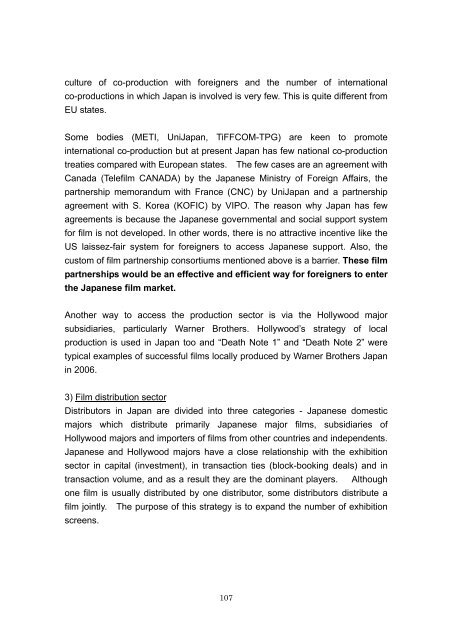The Japanese Market for UK Films - BFI
The Japanese Market for UK Films - BFI
The Japanese Market for UK Films - BFI
Create successful ePaper yourself
Turn your PDF publications into a flip-book with our unique Google optimized e-Paper software.
culture of co-production with <strong>for</strong>eigners and the number of international<br />
co-productions in which Japan is involved is very few. This is quite different from<br />
EU states.<br />
Some bodies (METI, UniJapan, TiFFCOM-TPG) are keen to promote<br />
international co-production but at present Japan has few national co-production<br />
treaties compared with European states. <strong>The</strong> few cases are an agreement with<br />
Canada (Telefilm CANADA) by the <strong>Japanese</strong> Ministry of Foreign Affairs, the<br />
partnership memorandum with France (CNC) by UniJapan and a partnership<br />
agreement with S. Korea (KOFIC) by VIPO. <strong>The</strong> reason why Japan has few<br />
agreements is because the <strong>Japanese</strong> governmental and social support system<br />
<strong>for</strong> film is not developed. In other words, there is no attractive incentive like the<br />
US laissez-fair system <strong>for</strong> <strong>for</strong>eigners to access <strong>Japanese</strong> support. Also, the<br />
custom of film partnership consortiums mentioned above is a barrier. <strong>The</strong>se film<br />
partnerships would be an effective and efficient way <strong>for</strong> <strong>for</strong>eigners to enter<br />
the <strong>Japanese</strong> film market.<br />
Another way to access the production sector is via the Hollywood major<br />
subsidiaries, particularly Warner Brothers. Hollywood’s strategy of local<br />
production is used in Japan too and “Death Note 1” and “Death Note 2” were<br />
typical examples of successful films locally produced by Warner Brothers Japan<br />
in 2006.<br />
3) Film distribution sector<br />
Distributors in Japan are divided into three categories - <strong>Japanese</strong> domestic<br />
majors which distribute primarily <strong>Japanese</strong> major films, subsidiaries of<br />
Hollywood majors and importers of films from other countries and independents.<br />
<strong>Japanese</strong> and Hollywood majors have a close relationship with the exhibition<br />
sector in capital (investment), in transaction ties (block-booking deals) and in<br />
transaction volume, and as a result they are the dominant players. Although<br />
one film is usually distributed by one distributor, some distributors distribute a<br />
film jointly. <strong>The</strong> purpose of this strategy is to expand the number of exhibition<br />
screens.<br />
107
















